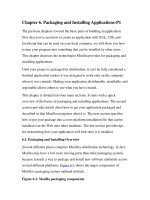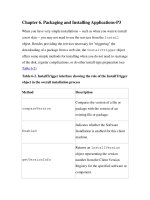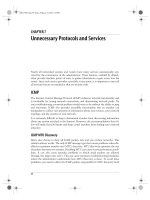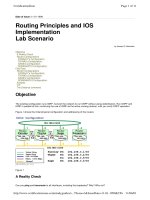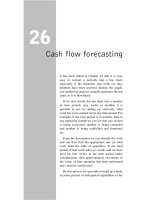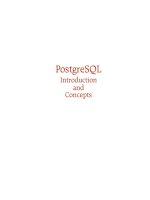Tài liệu Routing Protocols and Concepts: Chapter 6 pot
Bạn đang xem bản rút gọn của tài liệu. Xem và tải ngay bản đầy đủ của tài liệu tại đây (703.14 KB, 50 trang )
Chapter 6 VLSM and CIDR
Routing Protocols and Concepts
2
Topics
Classful and Classless
Addressing
Classful IP Addressing
Classful Routing Protocols
Classless IP Addressing
Classless Routing Protocols
VLSM
VLSM in Action
VLSM and IP Addresses
CIDR
Route Summarization
Calculating Route
Summarization
Classful and Classless
Addressing
Classful IP Addressing
Classful Routing Protocols
Classless IP Addressing
Classless Routing Protocols
4
Classful and Classless Routing Protocols
Routing protocols:
classful or classless.
This is a result of the evolution from classful to classless IPv4
addressing.
As networks began to use classless addressing, classless routing
protocols had to be modified or developed to include the subnet
mask in the routing update.
5
Classful IP Addressing
When the ARPANET was commissioned in 1969, no one anticipated that
the Internet would explode out of the humble beginnings of this research
project.
Over the next decade, the number of hosts on the Internet grew
exponentially, from 159,000 in October 1989 to over 72 million by the end
of the millennium.
As of January 2007, there were over 433 million hosts on the Internet.
Without the introduction of VLSM and CIDR notation in 1993 (RFC 1519),
Network Address Translation (NAT) in 1994 (RFC 1631), and private
addressing in 1996 (RFC 1918), the IPv4 32-bit address space would now
be exhausted.
6
High-Order Bits
In the original specification of IPv4 (RFC 791), released in 1981, the
authors established the classes to provide three different sizes of
networks for large, medium, and small organizations.
As a result, Class A, B, and C addresses were defined with a
specific format for the high-order bits.
7
IPv4 Classful Addressing Structure
RFC 790 (released with RFC 791).
Subnet mask for a network is determined based on its class.
Only choices were networks with very large number of hosts, large number
of hosts, or few number of hosts.
No medium sized networks
Only these three choices.
16,384
8
Classful Routing Protocol
Routing protocols, such as RIPv1, only needed to propagate the network
address, not the subnet mask.
Subnet mask of a network address could be determined by the value of the
first octet (or more accurately, the first 3 bits of the address).
The subnet mask was directly related to the network address.
9
Classful Routing Protocol
R2 applies s0/0/0’s /24
subnet mask (same
major network)
R3 applies the
default /16 subnet
mask (different
major network)
R1 sends a
subnet address
out s0/0/0 (same
major network)
R2 sends a summarized
route out s0/0/1
(different major network)
10
Moving Toward Classless Addressing
By 1992, members of the IETF had serious concerns about the exponential
growth of the Internet and the limited scalability of Internet routing tables.
They were also concerned with the eventual exhaustion of 32-bit IPv4
address space.
1993, IETF introduced classless interdomain routing (CIDR) (RFC 1517).
CIDR allowed the following:
More efficient use of IPv4 address space
Prefix aggregation, which reduced the size of routing tables
11
Moving Toward Classless Addressing
To CIDR-compliant routers, address class is meaningless.
The network portion of the address is determined by the network subnet
mask, also known as the:
network prefix, or
prefix length (/8, /19, and so on).
The network address is no longer determined by the class of the address.
ISPs could now more efficiently allocate address space using any prefix
length, starting with /8 and larger (/8, /9, /10, and so on).
ISPs were no longer limited to a /8, /16, or /24 subnet mask.
Blocks of IP addresses could be assigned to a network based on the
requirements of the customer, ranging from a few hosts to hundreds or
thousands of hosts.
12
11111111.00000000.00000000.00000000 /8 (255.0.0.0) 16,777,216 host addresses
11111111.10000000.00000000.00000000 /9 (255.128.0.0) 8,388,608 host addresses
11111111.11000000.00000000.00000000 /10 (255.192.0.0) 4,194,304 host addresses
11111111.11100000.00000000.00000000 /11 (255.224.0.0) 2,097,152 host addresses
11111111.11110000.00000000.00000000 /12 (255.240.0.0) 1,048,576 host addresses
11111111.11111000.00000000.00000000 /13 (255.248.0.0) 524,288 host addresses
11111111.11111100.00000000.00000000 /14 (255.252.0.0) 262,144 host addresses
11111111.11111110.00000000.00000000 /15 (255.254.0.0) 131,072 host addresses
11111111.11111111.00000000.00000000 /16 (255.255.0.0) 65,536 host addresses
11111111.11111111.10000000.00000000 /17 (255.255.128.0) 32,768 host addresses
11111111.11111111.11000000.00000000 /18 (255.255.192.0) 16,384 host addresses
11111111.11111111.11100000.00000000 /19 (255.255.224.0) 8,192 host addresses
11111111.11111111.11110000.00000000 /20 (255.255.240.0) 4,096 host addresses
11111111.11111111.11111000.00000000 /21 (255.255.248.0) 2,048 host addresses
11111111.11111111.11111100.00000000 /22 (255.255.252.0) 1,024 host addresses
11111111.11111111.11111110.00000000 /23 (255.255.254.0) 512 host addresses
11111111.11111111.11111111.00000000 /24 (255.255.255.0) 256 host addresses
11111111.11111111.11111111.10000000 /25 (255.255.255.128) 128 host addresses
11111111.11111111.11111111.11000000 /26 (255.255.255.192) 64 host addresses
11111111.11111111.11111111.11100000 /27 (255.255.255.224) 32 host addresses
11111111.11111111.11111111.11110000 /28 (255.255.255.240) 16 host addresses
11111111.11111111.11111111.11111000 /29 (255.255.255.248) 8 host addresses
11111111.11111111.11111111.11111100 /30 (255.255.255.252) 4 host addresses
11111111.11111111.11111111.11111110 /31 (255.255.255.254) 2 host addresses
11111111.11111111.11111111.11111111 /32 (255.255.255.255) “Host Route”
13
11111111.00000000.00000000.00000000 /8 (255.0.0.0) 16,777,216 host addresses
11111111.10000000.00000000.00000000 /9 (255.128.0.0) 8,388,608 host addresses
11111111.11000000.00000000.00000000 /10 (255.192.0.0) 4,194,304 host addresses
11111111.11100000.00000000.00000000 /11 (255.224.0.0) 2,097,152 host addresses
11111111.11110000.00000000.00000000 /12 (255.240.0.0) 1,048,576 host addresses
11111111.11111000.00000000.00000000 /13 (255.248.0.0) 524,288 host addresses
11111111.11111100.00000000.00000000 /14 (255.252.0.0) 262,144 host addresses
11111111.11111110.00000000.00000000 /15 (255.254.0.0) 131,072 host addresses
11111111.11111111.00000000.00000000 /16 (255.255.0.0) 65,536 host addresses
11111111.11111111.10000000.00000000 /17 (255.255.128.0) 32,768 host addresses
11111111.11111111.11000000.00000000 /18 (255.255.192.0) 16,384 host addresses
11111111.11111111.11100000.00000000 /19 (255.255.224.0) 8,192 host addresses
11111111.11111111.11110000.00000000 /20 (255.255.240.0) 4,096 host addresses
11111111.11111111.11111000.00000000 /21 (255.255.248.0) 2,048 host addresses
11111111.11111111.11111100.00000000 /22 (255.255.252.0) 1,024 host addresses
11111111.11111111.11111110.00000000 /23 (255.255.254.0) 512 host addresses
11111111.11111111.11111111.00000000 /24 (255.255.255.0) 256 host addresses
11111111.11111111.11111111.10000000 /25 (255.255.255.128) 128 host addresses
11111111.11111111.11111111.11000000 /26 (255.255.255.192) 64 host addresses
11111111.11111111.11111111.11100000 /27 (255.255.255.224) 32 host addresses
11111111.11111111.11111111.11110000 /28 (255.255.255.240) 16 host addresses
11111111.11111111.11111111.11111000 /29 (255.255.255.248) 8 host addresses
11111111.11111111.11111111.11111100 /30 (255.255.255.252) 4 host addresses
11111111.11111111.11111111.11111110 /31 (255.255.255.254) 2 host addresses
11111111.11111111.11111111.11111111 /32 (255.255.255.255) “Host Route”
ISPs no longer restricted to
three classes. Can now
allocate a large range of
network addresses based
on customer requirements
14
CIDR and Route Summarization
Recall from Chapter 2, “Static Routing,” that you can create one
static route for multiple networks.
Internet routing tables were now able to benefit from the same type
of aggregation of routes.
The capability for routes to be summarized as a single route helped
reduce the size of Internet routing tables.
A supernet summarizes multiple network addresses with a mask
less than the classful mask.
15
CIDR and Route Summarization
The 192.168.0.0/20, summarized or aggregated route includes all the
networks belonging to customers A, B, C, and D.
192.168.0.0/23, 192.168.2.0/23, 192.168.4.0/22, and 192.168.8.0/21 are all
subnets of 192.168.0.0/20
16
CIDR and Route Summarization
Propagating VLSM and supernet routes requires a classless routing protocol,
because the subnet mask can no longer be determined by the value of the first octet.
Although the network address is the same;
one is a subnet of the other.
The subnet mask is required in the routing
update to determine the network portion of the
address.
The network portion of the address is used by
the routing table to know whether or not the
destination IP address of the packet is a
match with the route in the routing table.
A classless routing protocol includes the
subnet mask with the network address in the
routing update.
17
Classless Routing Protocol
Classless routing protocols include the subnet mask with the
network address in their routing updates.
18
Classless Routing Protocol
With a classless routing protocol:
Networks 172.16.0.0/16, 172.17.0.0/16, 172.18.0.0/16, and 172.19.0.0/16 can be
summarized as 172.16.0.0/14, known as a supernet.
The /14 (255.252.0.0) subnet mask is included in the routing update.
With a classful routing protocol:
If R2 sends the 172.16.0.0 summary route without the /14 mask, R3 only knows
to apply the default classful mask of /16.
Classful routing protocols cannot send supernet routes because the receiving
router will apply the default classful mask to the network address in the routing
update.
VLSM
VLSM in Action
VLSM and IP Addresses
20
VLSM
The network 10.0.0.0/8 has been subnetted using the subnet mask of /16,
which gives the potential of 256 subnets:
10.0.0.0/16
10.1.0.0/16
10.2.0.0/16
.
.
.
10.255.0.0/16
21
Any of these /16 subnets can be subnetted further.
For example the 10.1.0.0/16 subnet is subnetted again using the /24 mask.
VLSM
22
The 10.2.0.0/16 subnet is also subnetted again with a /24 mask.
The 10.3.0.0/16 subnet is subnetted again with the /28 mask.
The 10.4.0.0/16 subnet is subnetted again with the /20 mask.
VLSM
23
Individual host addresses are assigned from the addresses of “sub-
subnets.”
For example, the 10.1.0.0/16 subnet divided into /24 subnets.
The 10.1.4.10 address would now be a member of the more specific subnet
10.1.4.0/24.
VLSM
10.1.4.10/24
24
VLSM: A different way to look at it
The 10.0.0.0/8 network is subnetted with a /16 mask on the first round of
subnetting.
You already know that borrowing 8 bits (going from /8 to /16) creates 256
subnets.
With classful routing, that is as far as you can go.
You can choose only one mask for all your networks.
With VLSM and classless routing, you have more flexibility to create
additional network addresses and use a mask that fits your needs.
25
VLSM: A different way to look at it
For subnet 10.1.0.0/16 (see Figure 6-10), 8 more bits are borrowed
again, to create 256 subnets with a /24 mask.
This mask will allow 254 host addresses per subnet.
The subnets ranging from 10.1.0.0/24 to 10.1.255.0/24 are subnets
of the subnet 10.1.0.0/16


